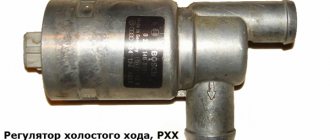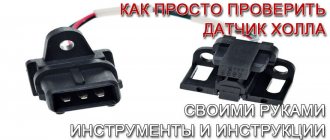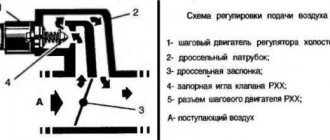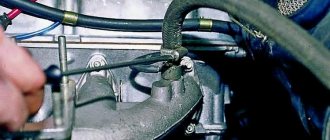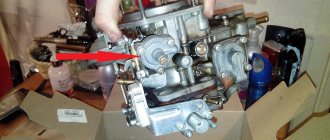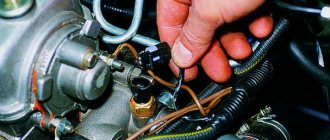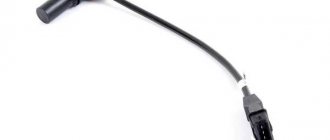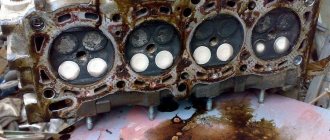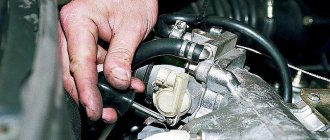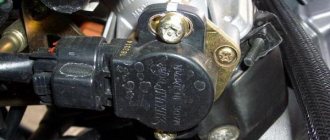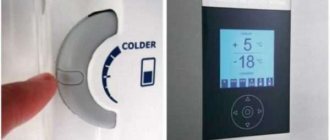Let's look at the operating principle of the idle air control (IAC) using the example of the IAC (idle air sensor) of the ECM of VAZ 21083, 21093, 21099, 21102, 2111.
The operating principle of the idle air control and the order of its operation in different modes
Based on a signal from the controller (ECU), at different engine operating modes, the idle speed regulator, by moving the rod tip, changes the size of the flow area of the bypass channel through which air is supplied to the throttle valve. The maximum extended position of the rod is the initial position (zero step). It can be observed with the engine not running and the ignition off. In this position, the cross-section of the bypass channel is completely blocked by the tip, and air does not flow under the throttle valve. A fully retracted rod corresponds to 255 steps of travel and a fully open bypass passage.
IAC operation when starting the engine
When starting and warming up the engine, when the throttle valve is completely closed, the controller, based on the readings of the temperature sensor, using the IAC, slightly opens the access of the required amount of air to maintain increased idle speed. As the engine warms up, it reduces the amount of incoming air - the speed drops to normal.
IAC operation at idle speed
On a warm engine, with the throttle valve closed, the controller, using IAC, provides the required idle speed. The regulator rod is retracted, the bypass channel is completely open.
IAC operation in medium and full load modes
When you press the gas pedal and open the throttle valve, air begins to flow into the engine intake manifold through the throttle valve section, and the IAC is set to a position in which, when the gas is released and the throttle valve is abruptly closed, a smooth reduction in engine speed to normal would be ensured. To determine the number of IAC steps in a given situation, the controller uses the readings of the crankshaft position sensor (crankshaft rotation speed), throttle position sensor (current throttle position), speed sensor (the car is moving or standing), etc. .
IAC operation with increasing load
When the load increases (turning on the cooling system fan, air conditioning compressor, etc.), the controller, using the IAC, increases the required volume of air entering the engine to ensure its power characteristics and prevent “failure” of speed in idle mode.
Notes and additions
— The idle air control is an element of the engine control system (ECM). This is an actuator. With its help, the control unit (ECU) regulates the amount of air entering the engine cylinders.
More articles on the principle of operation of elements of the electronic engine control system (ECM)
— Operating principle of the throttle position sensor
— Operating principle of the crankshaft position sensor
Modern cars are able to maintain idle speed on their own, thanks to smart electronic components. Namely, thanks to a special regulator (sensor). Let's look at how it works and how to check the idle speed sensor (IAC) with your own hands.
Small but important point
Its name speaks volumes about why an idle air regulator (or sensor) is needed. During engine operation, it is this sensor that is responsible for supplying a certain dosage of air, which is necessary to maintain minimum speed.
The sensor is located in close proximity to the throttle valve, but does not supply air through it, but bypass it through a special channel.
Of course, the idle speed sensor itself would hardly cope with such a difficult task, because maintaining speed is a troublesome task and depends on the outside air temperature, the load on the engine, and other factors that need to be taken into account.
The sensor operates under the strict guidance of the power unit's electronic control unit (ECU), which receives data on the state of the engine from a huge number of other sensors (air flow, crankshaft position, etc.).
IAC design: it's simple
The design of our today's hero of the article is very simple. The idle speed sensor consists of the following elements:
- stepper electric motor;
- spring-loaded conical needle.
The stepper electric motor, controlled by the computer, rotates to a certain angle, tightening or releasing the needle, which, in turn, slightly opens or, conversely, closes the bypass channel of the air supply, bypassing the throttle valve. That's the whole simple construct.
How to check the idle speed sensor yourself
So, we are gradually approaching the key question - how to check the idle speed sensor?
In fact, a number of symptoms may indicate a malfunction of this device, namely:
- incomprehensible jumps in engine speed, both up and down;
- when switching to low speeds, the engine stalls;
- connecting consumers (headlights, air conditioning, etc.) does not affect the speed, although they should change.
If you notice anything from this list, then it is time to diagnose the idle air control valve.
To do this, you can go to a car service center, or you can not spend extra money and do everything yourself, because the procedure is actually not too complicated. There are several ways to check the idle speed sensor yourself.
As a rule, the idle speed sensor is located not far from the throttle position sensor, but if this does not tell you anything, then you can open the technical documentation of the car, where the location of the IAC will be indicated. Once the unit has been found, it needs to be dismantled.
One method involves checking the idle speed sensor without any special instruments.
You just need to remove it and start the car - if the unit is working properly, then at the moment of start the IAC needle should move some short distance.
If this does not happen, then go to the auto store, but remember, the problem may not be in the unit itself, so the following method will more accurately indicate the malfunction.
For the second method, you will need a multimeter that measures voltage and resistance.
Having disconnected the sensor terminal, we measure the resistance between terminals A, B, as well as C and D - in both cases it should be in the range of 50 - 53 Ohms.
In turn, between contacts A and C, B and D, the device will show infinity.
These results indicate the serviceability of the idle speed sensor itself. Next, you will have to start the car and measure the voltage at the contacts of the connecting terminal going to the IAC.
Ideally, the device will show about 12 Volts. If there is no voltage at the terminal, then it is possible that the problem is not with it, but with the wires or the control unit, and here, most likely, you will have to contact specialists.
Well, that’s about it, friends, we learned how to check the idle speed sensor on our own. And now, if your car suddenly starts stalling at idle, you will know what to do.
1200 rub. for the photo report
We pay for photo reports on car repairs. Earnings from 10,000 rubles/month.
Write:
The meaning of the purpose of the IAC - idle speed regulator - follows from its name - stabilization of engine speed at idle.
Diagnosis of IAC
Ideally, diagnostics of the regulator should be carried out on a stand that can reproduce the pulses of the on-board computer. In practice, this is expensive; low-cost verification methods are used. In any case, the algorithm of actions at the initial stage is the same:
- the handbrake is applied, anti-recoil devices - shoes - are installed under the wheels;
- disconnect the “-” terminal from the battery;
- knowing where the TPS and MAF sensors are located, the location of the IAC is determined;
- the valve is disconnected from the on-board computer (the plug is pulled out of the connector).
Valve removal
Further steps differ for different verification methods.
Manual check
The simplest method for checking IAC in an electronic intake distribution system is manual diagnostics (an assistant will be required):
- the IAC plug is disconnected from the connector;
- two screws are unscrewed and the device is dismantled;
- the regulator is reconnected to the ECU, but remains in the hands of the master;
- The assistant starts the engine, at this time the rod should be completely retracted into the coils, then, having received an impulse from the computer, extend a certain distance.
Manual IAC check
In other words, the functionality of the stem is checked, the owner makes sure that this part is not bent or jammed inside the valve. However, this does not provide a 100% guarantee that this IAC modification fully complies with the controller ECU firmware. The needle extends, but by an unknown amount. In the first case, the connector is checked, in the second - the plug; the markings are only on the plug.
This is interesting: General information
In the classic version of checking “from simple to complex,” this stage is the initial stage; then you should check the integrity of the wires and coils, the condition of the bypass channel, and needle wear. Only after these steps can you assemble a homemade stand with a pulsed voltage supply for comprehensive diagnostics of IAC.
Diagnostics with a multimeter
At this stage, you will need an IAC tester, which is checked with this device in two modes:
- ohmmeter - when connecting contacts C – D and A – B with the multimeter probes, the resistance should have a value of 40 – 80 Ohms, D – C and A – D should be equal to infinity;
- with a voltmeter - when the ignition is turned on, the voltage reaches 12 - 20 V.
proverka-testerom
Attention: the IAC adjustment is performed automatically by the on-board computer after each connection of the device plug to the connector. After dismantling, it is recommended to lubricate the bypass channel with WD-40 spray to clean it. This measure is preventive, even in the absence of contamination of the bypass channel, in the gap of which the regulator is located.
Pulse testing on a homemade stand
Since the stand costs 1,500 - 1,800 rubles, and the regulator 300 - 500 rubles, purchasing the device is not economically profitable for the average user. A simple circuit without microchips is shown below:
- it uses 6 V charging from any mobile device;
- plug blocks are commercially available;
- First you need to disconnect the IAC from the on-board controller, then check the stroke of the rod;
- a bright glow of the lamp in the diagram indicates a malfunction of the rod itself;
- If the lamp burns at the incandescent level, the unit is considered to be in good condition.
Diagram of the device for checking IAC
Using a cleaning agent will restore the functionality of the rod, but only if it is clogged. If this part is bent, the entire regulator will need to be replaced.
Idle air control malfunctions
Like any other part, the IAC is not immune from breakdowns. In this case, the signs of failure are in many ways similar to those that arise when there are problems with the throttle position sensor. Only, unlike the TPS, an error notification (check engine) will not appear, since the XX regulator is an executive device.
A malfunction of the IAC can be judged by the following signs:
- Unstability of engine speed at idle, in some cases engine shutdown (if the speed is not maintained using the accelerator pedal).
- Decrease or increase in speed for no reason.
- A complete stop of the engine when the gears are engaged or when the car is moving away.
- During a cold start, the engine does not operate at high speeds.
- A drop in engine speed at idle when the headlights or heater are turned on. Next, we will consider the reasons for the malfunction of the idle speed control. There are only two of them:
- natural wear of the regulator needle guide;
- broken electrical contacts inside the regulator housing.
Replacement
When replacing the IAC, you need to pay attention to the position of the regulator valve stem. In no case should it be significantly advanced. This is possible if you connect it to the connector and turn on the ignition before installation. The rod cannot be pushed in manually.
If the regulator is installed with the rod extended and the installation bolts are tightened, the regulator may be damaged (shearing of the worm gear). A regulator with such a malfunction cannot be repaired.
After replacing the idle air control valve, some vehicles require a calibration procedure. It is performed using diagnostic devices on special equipment.
Why is it important to know how to check the idle air control (IAC)? The thing is that its functions include increasing the stability of idle speed, and the operation of the engine without load depends on this process. Malfunction will lead to problems with the most significant components of the car, so let's figure out what the essence of diagnostics is.
Removing/replacing IAC
Let's take a closer look at the process of dismantling and replacing the idle air control. It is worth immediately noting that on different cars the process may differ in some details, but in general the algorithm will consist of the following stages:
- All work must be performed with the engine turned off. It is also advisable to disconnect the negative terminal from the battery.
- Disconnect the connector (chip) of the contact going to the regulator.
- Unscrew the mounting bolts that secure the regulator body. At the same time, make sure that the unscrewed bolts do not fall into the engine compartment.
- Remove the regulator directly from its seat.
Installing a new regulator is performed in reverse order. However, before installation, it is necessary to lubricate the flange O-ring with engine oil. The brand in this case is not important, the main thing is that it is non-aggressive towards rubber. Also check the distance from the flange to the extreme point of the cone needle. It should be 23 mm . Such a gap is needed so that when installing the IAC, its conical needle cannot rest against the seat on the throttle body. The gap value can be adjusted using a special multitester or control pulse shaper.
Where is RHH located?
If you have an engine, then the regulator (in this case it is usually called the idle air solenoid valve) is located on the side of the device itself that prepares the fuel-air mixture. A single wire approaches the device (the second contact of the solenoid coil is connected to the vehicle ground through the carburetor body). Determining the location of the sensor on an injection engine is not so difficult: usually the regulator is installed next to the throttle valve and the TPS sensor, which determines its position. The IAC terminal block has four wires. In most cases, the idle air control is attached with a pair of screws, sometimes it is fixed to the throttle body using varnish.
If the latter method is used on your machine, then be careful when dismantling the device: it is best to first remove the throttle assembly.
How not to fall for a fake when choosing an IAC
If the check shows that the regulator is broken, you should be prepared to replace it, which was mentioned just above. If we talk about IAC on VAZ, then the idle speed controllers OMEGA and KZTA (Kaluga) stand out in terms of quality and reliability. Of course, we are talking about original parts, not fakes.
The fake part itself also has flaws. As a rule, this is play in the guide bushing and the cap itself. Over time, the backlash only increases, which negatively affects the operation of the IAC. In addition, there may be a gap on the regulator body, due to which air leaks will appear. Poor soldering of the contacts is also possible.
You can protect yourself from counterfeiting with the help of the manufacturer himself, who applies protective measures. This may be a unique spare part code, which can be verified via SMS or on the website.
